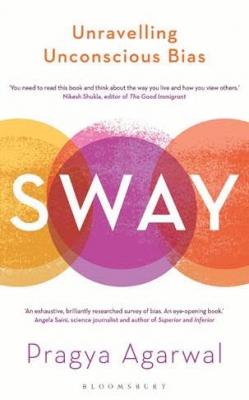By Vishnu Makhijani
New Delhi, Aug 22 (IANS) We all have our conscious biases but how do we deal with our unconscious biases that could do us enormous harm without our realising it?
Dr Pragya Agarwal, a behavioural and data scientist with a PhD from the University of Nottingham and a freelance journalist, tells you how in “Sway” that has been published by Bloomsbury.
“Unconscious bias is not just a ‘trend’ although there is a real danger of it becoming so. It is crucial that we use any understanding of implicit bias, training and measurement of our implicit attitudes as the foundation for further interventions in actively denigrating harmful stereotypes,” Agarwal writes.
She points out that training does not work without a change of attitudes and addressing systematic inequalities – which are often the result of stereotypes too.
“Taking our time with important decisions can help us de-automatize. This means that we do not fall back on our unconscious biases but instead activate our logical and rational thinking and actively bust any biases that can affect our decisions,” the author states
Being aware of how our own implicit biases are shape by our own upbringing and our life experiences can help us minimise these in our roles as parents, carers, friends and educators.
“This us crucial so that parents and educators can limit the transmission of bias. One way that I encourage adults to break this cycle of gendered norms and stereotypes is via the moderation of information related to social categories in their language,” Agarwal explains.
So, rather than using generic language such as “boys like dinosaurs” or “girls like pink”, parents could signify that a particular attribute is associated to an individual rather than the whole group such as “This boy is good at maths”.
“In the first case, the words signify that such attributes are enduring properties of the whole group, and highlights group differences while also signifying to children that such group distinctions . In the second case, essentialist tendencies and stereotypes can be reduced and the formation of rigid social group boundaries avoided. This will minimise in-group and out-group behaviour as well as the need and expectation to conform to any pre-existing and normative standards,” the author states.
Also, it is important to create safe, non-judgemental spaces in an organisation to discuss the issue. It is also important to criticise the micro-aggression rather than the micro-aggressor so that the focus remains on how that statement has made the other person feel rather than apportioning blame. If you are the micro-aggressor, use empathy and do not get defensive.
“Try to acknowledge and recognise your unconscious biases, reflect on them and the hurt your words might have caused. For others, it is important to act as an ally rather than speaking out for someone else who has suffered micro-aggression, since this is an act of aggression itself, dehumanising them and indicating that they do not have their own voice and cannot stand up for themselves,” Agarwal writes.
Noting that micro-aggressions are causes and symptoms of larger systemic and structural problems, she adds that calling out micro aggressions can serve as a deterrent.
“Accountability and empathy together can help to create more thoughtful and inclusive communication across all the divides of race, gender, sexual orientation and gender identity. Overall, it is important to recognise that jokes about anyone’s race, gender, ethnicity or sexual orientation are never OK. They perpetuate the racism and sexism that exists in this society and, even though they might seem harmless, they reinforce discrimination and prejudice.
“To avoid confirmation bias during hiring and recruitment, write an inclusive job description – language matters. Use gender-neutral descriptions and avoid gender-coded words. Research has also shown that women are less like to apply for jobs that have a very long list of ‘desirable’ qualities, as they do not wish to waste the employer ‘ s time if they are not perfectly suited to the role. Women are also less likely to shout about their achievements and to negotiate salaries,” the author states.
What must also be remembered is that role models and representation matter because when we see them we can begin to individuate, question pre-existing stereotypes, and visualise from another person’s perspective.
Invisibility, says the author, contributes to marginalisation and stigmatisation of a group. However, diversity should never be merely a box-ticking exercise. True inclusivity happens when people are given equal voice. And sometimes, to overturn the tide of oppression and marginalisation through history, positive discrimination might be necessary. Equality is not equity. People have to start from the same place for them to be equal.
“Finally, unconscious bias is never an excuse for discriminatory behaviour. Not every bias is unconscious and outside the control of the person. There are biases that we can control once we are aware of the way they influence our decisions. Unconscious bias training does not exonerate an individual from taking responsibility for their actions and their role in creating inequities and amplifying injustice,” Agarwal concludes.
“Sway” is a valuable contribution to the literature on understanding human nature with its significant words of wisdom in these trying times.
(Vishnu Makhijani can be reached at vishnu.makhijani)
–IANS
vm/

